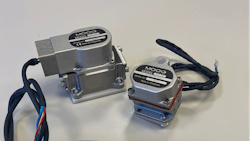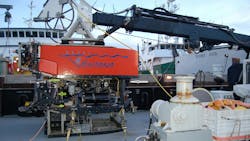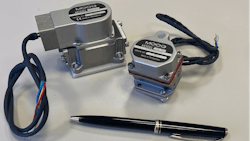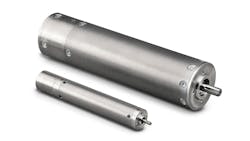Micro-Hydraulic Valves Provide Compact Yet High-Performance Solution
While virtually every facet of industry is either opting for, or contemplating the switch to, fully electric solutions, there are still many segments committed to using hydraulics, including micro-hydraulic valves.
Engineers opt for these servo valves because they offer a compact, lightweight package with a high power-to-weight ratio. Micro-hydraulic valves can weigh as little as 95 grams (3.4 oz) and provide operating pressure of 280 bar (4,061 psi) with a rated flow up to 7.5 lpm (1.98 gpm).
These mini valves are commonly used in applications requiring high power density, but unlike a standard valve, they can be four-way valves. With their servo-controlled feedback, if given a command, the valves will flow at a certain rate and can instantly change that rate with a linear command.
Micro-hydraulic valves can provide benefits to a range of applications including undersea robots, motorsports, entertainment, oil & gas drilling, and even airships, as demonstrated in the use cases from Moog Inc. outlined in this article.
Micro-Hydraulics Take a Deep Dive in Subsea Vehicles
Subsea remotely operated vehicles (ROV) are equipped with manipulator arms for grabbing or placing items. The arms can have up to seven micro-hydraulic servo valves each as part of a control cabinet and operate more than a mile below sea level.
For undersea applications, the servo valve’s integrated torque motor is submerged in hydraulic fluid and pressurized within the control cabinet because at such great depths any air left inside would collapse the valve and motor. To prevent contamination of the environment, the hydraulic fluid contains a water-glycol mixture operating much the same as if it were working with mineral fluid.
Several years ago, the Monterrey Bay Aquatic Research Institute (MBARI) wanted to replace the valves controlling the cameras and manipulator arms on the institute’s Ventana ROV. After 16,000 hours of use and undersea pressure, the legacy valves’ asymmetric design, which occupied an envelope within the Ventana’s stern manifold, required replacement.
No replacement valve on the market could fit within the ROV’s envelope and handle up to 3,000 psi (207 bar) while reducing the latency between the pilot’s movements and the positioning of the manipulator arms and attached camera. With the legacy valves, the MBARI technical team would trim the amount of pressure to the hydraulic system by putting the ROV’s pump into bypass and give the manipulator arm more finesse. When the team did this, there was a shift in the “null” of the legacy servo valves.
MBARI asked Moog Inc. to solve a threefold challenge. First, design a set of valves that would fit within the existing envelope. Second, eliminate the pressure center shift. And third, combat the latency issues that caused the pilot to repeatedly move the manipulator arms and cameras to hunt for specimens or targets.
Moog was also told the Ventana was originally built for $795,000; replacing the vehicle would cost MBARI $3.2 million. So, retrofitting the vehicle was critical for MBARI’s program.
Moog’s solution included its Micro-Sized 30-Series Servo Valve, measuring 4.0 x 3.4 x 3.9 cm (1.6 x 1.3 x 1.5 in.). The valves are a split manifold handling hydraulic pressure up to 3,000 psi and offer a step response of 2.5 milliseconds. Moog engineered the valve to fit the correct valve configuration, within an envelope smaller than the legacy valves.
According to MBARI, the micro-valves eliminated the latency with the video and controls. And MBARI said the ROV’s system is easier to tune. Moog also enabled MBARI to use software to get the best performance from the valves and camera angles, which expedites time spent underwater studying things like seal life and geology.
According to Russ Miliotto, a senior product engineer for Moog with 35 years of experience, the Micro-Sized 30-Series Servo Valves were originally made for defense and space applications. Miliotto notes the valves were first used for controlling thrust vectors on missiles and unmanned spacecraft.
“We took the space and defense valves and industrialized them,” said Miliotto. “Previously, the valves used castings, but for industry we use materials like stainless steel and Viton™ seals.”
Miliotto said the industrial version of these valves are less expensive than the military-grade version. There isn’t a need to put them through shock tests, he added, because the micro-valves are already a proven design.
Perfecting Motorsport Tests with Micro Valves
In motorsports, the distance between a car’s floor and the surface of the track is called ride height. If the ride height is lower to the ground, the driver’s car has better grip and a lower center of gravity. A slightly higher ride height helps a car and driver better handle undulations and bumps in a course. Getting the measurement right means a competitive advantage to racing teams.
Micro-hydraulic servo valves weighing 95 grams play a critical role as a component on ride height systems. These lightweight, high-performance valves can rapidly adjust the car’s suspension. The micro valves have a step response of less than 3 milliseconds. As a component of an active suspension system, the valves help the vehicle feel the forces and move the ride height for less drag.
At the Honda Automotive Laboratories of Ohio (HALO) facility, Honda asked Moog to provide an active ride height system for test vehicles in the lab’s wind tunnel, which can generate wind speeds up to 306 km/h.
Moog teamed up with Cosworth, a provider of software and hardware for Formula 1, to design a system that replaced the conventional on-car suspension, which was limited in how low the ride height could be adjusted for fear of contacting the test equipment’s moving belt. Moog’s system controls the ride height, pitch, and roll, preventing a vehicle from oscillating at high downforce levels during aerodynamic tests.
Part of the system developed for HALO’s test solution utilizes micro-hydraulic servo valves that, among other things, operate hydraulic actuators controlling a fail-safe system to lock the vehicle if there is a power outage or when the system is switched off.
READ MORE: Moog Motion Control Technology Aids Creation of High-Performance Test Rig
Theme Park Rides Put New Twist on Use of Micro-Hydraulics
Moog’s Miliotto said the entertainment industry began inquiring 30 years ago about military flight simulators that could be the foundational technology for theme park rides. Many parks began installing simulator rides decades before these platforms became fully electric.
Although the theme parks are constantly updating their rides, the prior designs are a foundation to build on for convenience and economics. This means there is an opportunity to improve these rides with high-performance micro-hydraulics, especially since many of the ride platforms predate fully electric actuation.
“The hydraulics on an entertainment ride can offer a very smooth movement,” said Miliotto. “Whereas with electric actuation, you may not always get that with a ball screw.”
Fail safes can be limited with electric designs, added Miliotto. If, for instance, you lose an electric signal to a valve, a designer could make a failsafe with a bias to drive the piston back home. If you lose an electronic signal on an electric cabinet, the designer must rely on battery power and motors (or gravity) to drive the ride’s piston to the home position.
Valves That can Take the Heat and Pressure
Micro-hydraulics also include variants that incorporate a vented motorcap to operate in high ambient pressure environments, meeting the needs of downhole oil & gas applications. These use cases include measurement-while-drilling (MWD), wireline, and rotary steerable systems.
Miniature hydraulic valves help steer a drill so it can turn corners underground and drill horizontally. In this type of application, oil and gas companies rely on micro-hydraulic valves weighing 195 g (6.9 oz) and servo motors measuring 8 mm (0.3 in.) in diameter because they can stand up to temperatures of 177 C (351 F), pressures of 25,000 psi (1,724 bar), and shock as high as 250 g.
For MWD, downhole motors are part of a drilling company’s bottom hole assembly and control the valve generating mud pulses to the surface. These mud pulses help operators and drillers make decisions about drilling as it happens. For wireline operations — which use special cable in a borehole to collect data — motors and micro-hydraulic valves facilitate the extraction of sidewall cores and fluid samples for analysis.
Micro-Hydraulic Valves Keep Airships on Course
Along with the power of micro-hydraulic valves comes their advantage as an incredibly lightweight technology. For airships, almost everything is about weight.
To control an airship’s rudder, designers opt for small, lightweight servo valves to complement motors. Airship makers rely on a hydraulic system of rudder control for blimps. When the valve one airship manufacturer had long used became obsolete, Miliotto’s colleague Kellsi Ellis, an engineering team leader for Moog, said the company stepped in with a micro-hydraulic servo valve to provide motion control within the required design envelope.
“To redesign a system, especially a successful one, from hydraulic to completely electric might simply cost too much,” noted Ellis. “There are a lot of hydraulic applications like this, and customers want a replacement product. We can take micro-hydraulic servo valves and use them to replace valves on machines from the 1960s or even 1950s; you’re not going to replace these products with electronics.”
According to Miliotto, micro-hydraulic valves often find their way into a design as a replacement for an older product that is no longer made. For instance, explosion-proof valves and intrinsically safe valves require a manufacturer to invest a lot to maintain the certification, he said. If the sale of these valves isn’t particularly high, then the valve maker may eliminate the product line.
“Micro-hydraulic valves are all about the power density; it’s horsepower per ounce, and if you need 100 hp, you’ll generally need a much larger electric solution for that,” added Ellis.
This article was written and contributed by Bill Perry on behalf of Moog Inc.
About the Author
Bill Perry
Bill Perry has written about the utility, manufacturing and aerospace industries for nearly 30 years and lives in Upstate New York.

Leaders relevant to this article:




